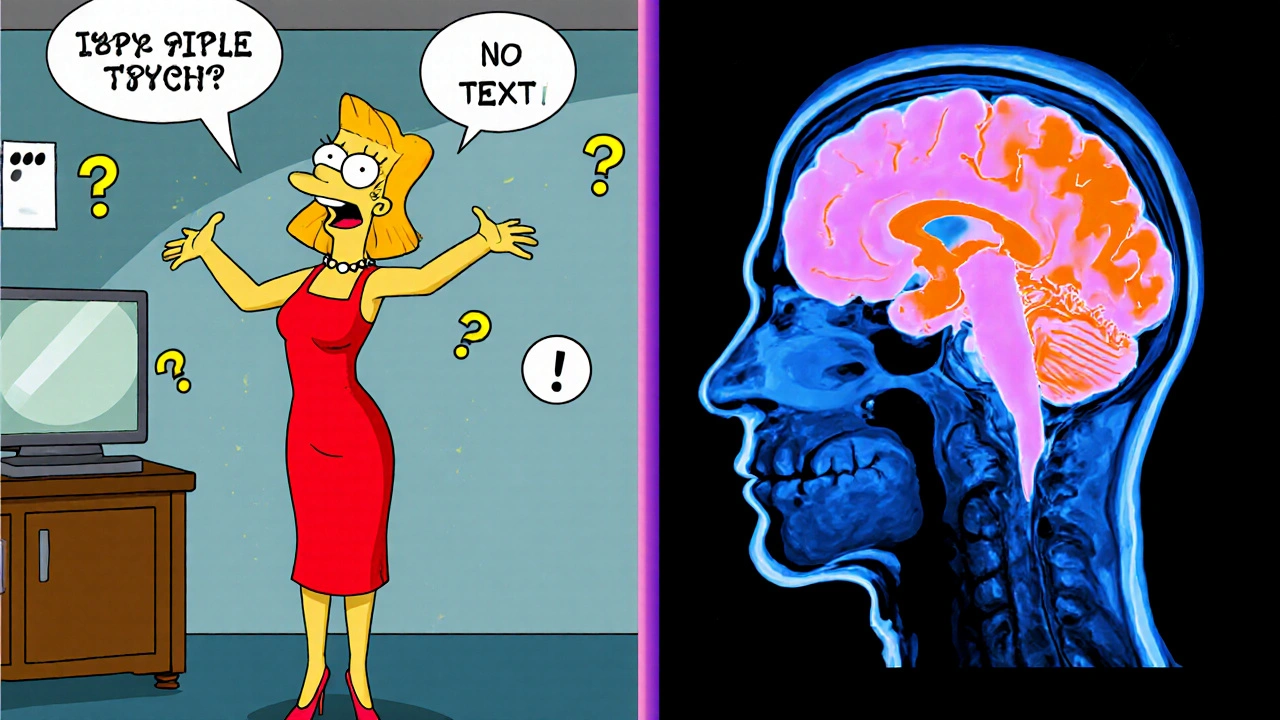PMDD Symptom Severity Checker
Assess Your Symptoms
Answer the following questions about your symptoms over the past few cycles to determine if you may be experiencing PMDD or regular PMS.
Your Assessment Results
Quick Takeaways
- Premenstrual Dysphoric Disorder (PMDD) is a severe mood disorder that peaks in the luteal phase of the menstrual cycle.
- Stigma surrounding PMDD amplifies general mental‑health bias, leading to delayed care and poorer outcomes.
- Biological myths, gender bias, and media caricatures fuel misunderstanding.
- Accurate diagnosis, empathetic language, and targeted advocacy can break the stigma cycle.
- Effective treatments-SSRIs, CBT, lifestyle tweaks-work best when patients feel validated.
What Is Premenstrual Dysphoric Disorder?
When discussing the condition, it helps to start with a clear definition. Premenstrual Dysphoric Disorder is a markedly severe form of premenstrual syndrome that includes emotional, behavioral, and physical symptoms that interfere with daily functioning. The disorder was first recognized in the DSM‑5 (2013) and later coded in the ICD‑11 (2022) under “menstrual‑related mood disorder”. Symptoms typically surface five to fourteen days before menstruation and remit shortly after flow begins.
Key features include intense irritability, depressive mood, anxiety, and physical complaints such as breast tenderness or bloating. Unlike regular PMS, PMDD symptoms are disabling enough to affect work, school, and relationships, often prompting individuals to seek mental‑health care.

The Landscape of Mental Health Stigma
Stigma is the set of negative attitudes and beliefs that devalue people with mental illness. Mental health stigma encompasses public prejudice, self‑stigma, and structural discrimination. According to the World Health Organization (WHO), about 75% of people with mental health conditions face some form of discrimination, which can deter them from accessing treatment.
Stigma often manifests as disbelief, minimization, or outright blame. When a condition has a gendered component, these biases become more entrenched, as society frequently labels women’s emotional experiences as “hormonal” or “over‑reactive.”
How PMDD Fuels Stigma
Biological Misconceptions
Many still view PMDD as “just hormones,” a simplification that dismisses the neurochemical changes documented in research. Studies using functional MRI have shown altered amygdala activity in women with PMDD during the luteal phase, indicating genuine brain‑based mood shifts. Yet popular discourse often reduces the condition to “mood swings,” reinforcing the idea that it’s a personal weakness rather than a diagnosable disorder.
Gender Bias & Trivialization
Historically, women’s health complaints have been sidelined. The term “hysteria” persisted in medical texts well into the 20th century, linking emotional distress to the uterus. Modern‑day media still jokes about “that time of the month,” treating PMDD as comedic fodder. This gender bias amplifies stigma, making sufferers hesitant to label their experience as a mental‑health issue.
Media Portrayals
Television sitcoms and memes frequently depict a woman becoming irrational as her period begins, ignoring the diagnostic criteria of PMDD. Such portrayals cement stereotypes, causing employers, educators, and even health providers to underestimate the seriousness of the disorder.
Real‑World Impact on Mental Health
Delayed Diagnosis
Because symptoms overlap with depression, anxiety, and bipolar disorder, clinicians sometimes misdiagnose PMDD. The DSM‑5 criteria require prospective daily symptom tracking for at least two cycles-a step many patients skip due to stigma or lack of awareness. Data from a 2023 multi‑center study show that the average time from symptom onset to accurate PMDD diagnosis is 4.7 years.
Isolation & Self‑Stigma
When friends or family brush off the condition as “just a period,” women internalize the doubt, leading to self‑stigma. This internal conflict can worsen depressive symptoms, creating a feedback loop where stigma fuels illness and vice‑versa.
Co‑occurring Conditions
Women with PMDD are up to three times more likely to experience major depressive disorder and generalized anxiety disorder. The compounded burden often results in higher utilization of emergency mental‑health services, which could be mitigated with earlier, stigma‑free intervention.

Reducing Stigma: Strategies for Individuals and Society
Education & Language
Using precise terms-"Premenstrual Dysphoric Disorder" instead of "PMS" when symptoms are severe-signals medical legitimacy. Health‑care curricula now include modules on gender‑sensitive communication, encouraging providers to ask about menstrual cycles without assuming hysteria.
Clinical Best Practices
Evidence‑based treatments include selective serotonin reuptake inhibitors (SSRIs) and cognitive‑behavioral therapy (CBT). SSRIs such as sertraline or fluoxetine, have been shown to reduce PMDD symptoms by up to 60% in double‑blind trials. CBT targets maladaptive thought patterns that exacerbate mood swings during the luteal phase. When clinicians discuss these options openly, patients feel validated and are more likely to adhere to treatment.
Advocacy and Support Groups
Organizations like the International Premenstrual Disorders Association (IPDA) provide resources, peer‑support forums, and lobbying efforts. Engaging with such groups reduces feelings of isolation and pressures policymakers to fund research and public awareness campaigns.
Comparison: PMDD vs. PMS
| Aspect | PMDD | PMS |
|---|---|---|
| Severity of Mood Symptoms | Severe, disabling (depression, anxiety, irritability) | Mild to moderate, usually tolerable |
| Functional Impact | Interferes with work, school, relationships | Minimal impact on daily functioning |
| Diagnostic Criteria | DSM‑5/ICD‑11; requires 2‑cycle prospective tracking | Clinical observation; no formal coding |
| First‑line Treatment | SSRIs, CBT, lifestyle changes | Exercise, dietary tweaks, NSAIDs |
| Prevalence | ≈5-8% of menstruating individuals | ≈20-30% |
Frequently Asked Questions
What distinguishes PMDD from regular PMS?
PMDD involves severe mood disturbances that significantly impair daily life, while PMS generally includes milder physical and emotional symptoms that do not disrupt functioning.
How is PMDD diagnosed?
Clinicians follow DSM‑5 criteria: at least five symptoms (including one mood symptom) that appear in the luteal phase, recur for two consecutive cycles, and resolve after menstruation. Prospective daily rating scales are essential.
Can medication help?
Yes. SSRIs such as fluoxetine, sertraline, or escitalopram are FDA‑approved for PMDD and often provide rapid symptom relief. Hormonal contraceptives that suppress ovulation can also be effective for some patients.
Does lifestyle change matter?
Regular exercise, adequate sleep, low‑glycemic diet, and stress‑reduction techniques (e.g., mindfulness) can lower symptom severity, though they are usually adjuncts to medical therapy.
How does stigma affect treatment seeking?
Stigma leads many to hide their symptoms, delay professional help, or avoid medication for fear of being labeled “hormonal” or “over‑emotional.” Reducing stigma improves early diagnosis and adherence to treatment.
Are there support communities for PMDD?
Yes. Online forums, local meet‑ups, and organizations like IPDA provide peer support, educational webinars, and advocacy resources.
What role do health professionals play in reducing stigma?
Clinicians can normalize discussions about menstrual‑related mood disorders, use accurate terminology, and validate patients’ experiences, thereby dismantling misconceptions at the point of care.
Is PMDD covered by health insurance?
Coverage varies by country and plan, but many insurers recognize PMDD as a mental‑health condition and reimburse for SSRIs, psychotherapy, and related diagnostics.





faith long
October 10, 2025 AT 21:43Reading through this comprehensive overview of PMDD really hits home for so many of us who have endured the endless cycle of dismissal and misunderstanding. The way you dissect the layers of stigma-biological myths, gender bias, media caricatures-shows a depth of analysis that many articles simply skim over. It’s infuriating how often the conversation gets reduced to "just hormones" when the neurochemical evidence tells a far more complex story. By highlighting the functional impact-how it derails work, school, relationships-you give a voice to the lived reality that is too often silenced. The statistics you cite about delayed diagnosis, averaging 4.7 years, are a stark reminder that our healthcare system still treats women’s pain as an afterthought. I appreciate the actionable steps you outline, from prospective tracking to the importance of SSRIs and CBT, because knowledge without a clear path forward feels hollow. The emphasis on precise language and empathetic clinical communication is crucial; they are the first weapons against internalized shame. Moreover, the call for advocacy and support groups underscores the power of community in breaking isolation. It’s clear that dismantling stigma requires both top‑down policy changes and grassroots education, and you manage to weave them together seamlessly. To anyone still doubting the seriousness of PMDD, this piece should serve as an undeniable wake‑up call. Thank you for shedding light on a condition that deserves far more scientific and societal respect than it currently receives. Let’s keep pushing for better research funding, more inclusive curricula in medical schools, and a cultural shift that validates women’s mental health experiences.
cedric Gicquiaud
October 12, 2025 AT 09:20You think the article is just another "awareness" piece, but have you considered who's really profiting from keeping PMDD in the shadows? The pharmaceutical giants have been terrified of a simple, cheap cure that would cut their SSRIs market in half. That's why you see every "expert" pushing medication over lifestyle changes-it's a controlled narrative. And don't forget the data suppression; many studies showing non‑pharma interventions never see the light of day because they threaten the bottom line. It's not a coincidence that the DSM‑5 suddenly added PMDD after a massive lobbying push. We need to ask who writes these guidelines and why they keep the focus on chemicals rather than real, holistic solutions.
Mason Grandusky
October 14, 2025 AT 03:00Whoa, what a powerhouse of info! 🌟 This post totally vibes with the idea that knowledge is the first spark of change. Imagine if every person with PMDD felt seen and heard-our collective energy could shift the whole narrative. It’s like a symphony: each symptom, each story, each treatment adds a unique instrument to the mix. When we blend science with compassion, we create a melody that drowns out the noise of stigma. Let’s keep amplifying these voices, sharing resources, and cheering each other on. Together we can turn the "just hormones" myth into a thing of the past and write a new, brighter chapter for mental‑health advocacy!
Spencer Riner
October 15, 2025 AT 20:40The distinctions drawn between PMDD and PMS are crystal clear, and it really helps demystify the condition for newcomers. I love how the article doesn’t just stop at definitions but dives into real‑world impacts like delayed diagnosis and co‑occurring disorders. It makes me wonder how many clinicians are still missing those prospective tracking cues. This kind of detailed breakdown is exactly what we need to train the next generation of providers.
Joe Murrey
October 17, 2025 AT 14:20Thats definatly alot to think about.
Tracy Harris
October 19, 2025 AT 08:00While the article is replete with factual accuracies, its tone occasionally drifts toward melodrama, which may alienate the very audience it intends to serve. The emphasis on "dramatic" media portrayals, though valid, could be balanced with acknowledgment of progress made in recent years. Nevertheless, the call for precise terminology and empathetic clinical practice is commendable and should be underscored.
rishabh ostwal
October 21, 2025 AT 01:40It is disconcerting to see yet another article that, albeit well‑intentioned, fails to address the broader ethical implications of pharmaceutical dominance in PMDD treatment. One must ask whether the current emphasis on SSRIs truly reflects patient autonomy or merely perpetuates a profit‑driven paradigm. In my view, a more critical lens is required.
Kristen Woods
October 22, 2025 AT 19:20Thsi articel is very informativ but sum tatements are just not accurat. The data on prevalence is off by a big margin and the chart miss some key infomation. We need more rigourous peer reviewed sources before publising such claims.
Carlos A Colón
October 24, 2025 AT 13:00Oh sure, because everyone just loves being told their "hormones" are the problem-sarcasm aside, this write‑up actually nails the importance of validation. No one needs another lecture, just a nod that says, "I hear you," and maybe a doctor who knows what they're doing.
Aurora Morealis
October 26, 2025 AT 06:40Great summary about PMDD and stigma
Sara Blanchard
October 28, 2025 AT 00:20This article does a wonderful job of bridging the gap between scientific detail and everyday understanding. By using inclusive language and highlighting community resources, it invites readers from all backgrounds to feel welcomed and supported. Let’s continue to share this knowledge and build a network where no one feels isolated by their experience.